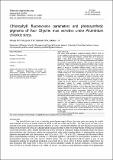| dc.description.abstract | Soy bean (Glycine max L.) is a commonly grown legume crop in Kenya. Soy bean grains are
among the world's most important in terms of protein content of 35-40% and oil content of 15-
22%. Soy bean grains are also rich in essential amino acids, vitamins and minerals (Alvim et
al., 2012). Considerable attention has been focused on assessing the impact of aluminium
(Al) stress on cultivated plants because its stress is often the primary factor limiting crop
production in acid soils (Kochian, 1995). Soluble aluminium is toxic to the roots of most
plants leading to reduced growth and reduces plant production rate. Aluminium reaches the
photosynthetic cells posing negative effects on photosynthetic accessory pigments
associated with both photosystem I and II (Cai et al., 2011). Cai et al.(2011) observed that
Aluminium affects plants physiologically including the quantity of chlorophyll pigments … | en_US |

